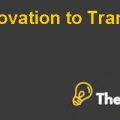Factors influencing thelevel of IT-Business Strategic Alignment Case Study Analysis
Research Design:
In this study, a qualitative research design is used. Due to the fact that this design is considered as the most appropriate one in order to evaluate the impact of factors on the IT-Business Strategic Alignment. As it provides the researcher with the opportunity for analysis of the response of senior executives against different factors in the business operations. The qquestionnaire was used as an instrument for the collection of qualitative data which comprised open-ended questions. The observation of the business organization will be an unstructured observation as it provides flexibility between employees and researchers for attending other events or activities associated with the business strategy and IT strategy in the organization. Additionally, the unstructured observations allow the researcher and employeesto shift their concentration from one to the other event.
The management of the business strategy in alignment with the IT strategy is a complicated initiative that involves the role of different variables at play. Therefore, it helps in locating behavioural responses and strategies and thus is improved through audiotape allowing the researcher to compare the notes of transcription with the notes of the field for authority. The other reason for taking notes and the use of audiotapes is to assist the researcher in ensuring the collection of data and the process of interpretation validity. It is for checking of data with the context of members if possible, to determine the evidence weight.
Data Collection and Analysis:
The random selection of employees from the working groups within the organization involved both males and females will get distinctive instructional strategies in a bid for the measurement of strategy effectiveness and their influence on the achievement of successful IT-business strategic alignment. The selection of participants of the study will only involve those employees who tend to be associated with the IT department and business operations. These classes comprise different elements like communication, representation, connections, problem-solving and reasoning and standards of cross-disciplinary such as behavior, work habits and technology use.
Conclusion and Recommendation:
Considering the analysis of the theoretical frameworks and the organizational observations through conducting the research analysis by means of questionnaire provided the insight regarding the issues associated with the IT-business alignment. The analysis of the factors influencing the organizational IT-business strategic alignment tend to enhance the strategic alignment level and maximizing its support in the excellence of the organization. The analysis of the influence of the factors on the IT-business strategic alignment is used for the employees and decision-makers of the organization.
Considering some limitations of the study, this is primarily focused on the analysis and reporting of the questionnaire parts. The designed questionnaire was piloted with experienced IT & business strategy and other changes based on the clarified meaning of the questionnaire. The assessment of the survey was presented with respect to the survey questionnaire regarding the information about the background of the organization, business strategy, strategy about information technology and the factors promoting business and IT strategy alignment.
The outcome of the study mainly represented the influence of the strategic business alignment between the strategy of the organization, culture, its process, IT skills of the employees and leadership to demonstrate their own importance in the business operations. The influence of leadership and the organizational culturewere more in comparison to the other factors. This primarily based on the reason that organization with demonstrating the transformational leadership style enables the leader adaptation to change, high level of commitment and motivation, achievement of potentials and empowerment. (Anona Armstrong, 2014 )
While on the other hand, the key factors in importance primarily included structure, skills and process between the decision-makers’based on the capability and skill management in business and IT. The management of the organization take strategic actions in order to bring improvement in the organizational processes and enhance the level of IT-business alignment in the organization through directing all the investment in bringing improvement in the technological approaches through significant investment in the information technology. This is primarily based on the notion to better serve the strategy of the organizationand successful alignment of the business and IT plans.
The justification of the making investment in order to improve the influence of such factors tend to be basedon the read added value to the overall strategic approach of the organizational process. Considering the fact that the openness and flexibility in the organizational structure and the strategic approaches of the organization tend to serve as anentertaining factor in the relationship of complementaritieswith the information technology influencing the performance of the organization. Furthermore, the analysis of the outcome demonstrated the organizationalculture is one of key factors that greatly influences the perception of employees as average.
This has influenced the productivity and the motivation of the employees influencing their performance at the organization. Thus, there is a requirement to improve the organizational culture which is mainly driven by two factors i.e. cultural diversity and communication gap. Based on the fact that the healthy operational services and the culture of the organization is considered one of the key important factors influencing the long-term and stable success of the organization and ensure the compatibility of the alignment between the IT and business strategic approaches. (Ekaterine Gulua, 2018)Therefore, the organization is required to bring improvement in the efforts to successfully align the IT-business strategic approaches at this level of digitalization.
The improvement in alignment was based on the encouragement by the top management for the business involvement in the information technology planning and discourage would represent opposite outcomes. (Mendelow, 1989)(Kambil, 1999) Thus, the emergence of new IT managers can be seen to move beyond the regaining control, leading the organization for supporting the evolving strategies of the organization and the fire-fighting behaviour of managers. (Pannian, 2005)In contradiction, the strategic use of information technology by the small and medium sized organization tends to positively influence the performance of the organization is known to bring improvement in the investment growth in the information technology.
Therefore, the assessment of the influence of the strategic use of information technology on the investment on information technology tend to serve as an important area for the future research. Thus, the organizations are recommended to bring significant improvement in the organizational process through the increased investment in the research and technological in order to make the IT and business alignment more efficient and effective. This significantly increased the productive outcome of the implementation of the strategic approaches in the organization.
Furthermore, the examination of the information technology paradox at the working environment of the organization among all the small and medium sized organizations as well as leading firms to remain focused on the impact of the investment in the information technology and the strategic use of the information technological approaches to improve the performance of the business of the companies across the world. On the other hand, the change in the leadership style is known to influence the organizational culture. This is due to the reason that there is a difference in being a leaders and a boss. The role of the top management of the organization is known to manage the organizational operations through involving the employees in the process of decision-making.
Similarly, the reduction in the communication gap and increase the productivity of the employees is known to bring improvement in the organizational structure resulting in the increased harmony level and flexible operations. Thus, both new and old employees offering their services in a particular organization must be provided with the training in order to develop and enhance the skills of the employees related to information technology business strategic alignment. (Jee, 2007) This mainly requires increased investment that can be significantly analysed through the industrial feedback and the strategic approaches used in the industry through market research.........................
This is just a sample partical work. Please place the order on the website to get your own originally done case solution.











